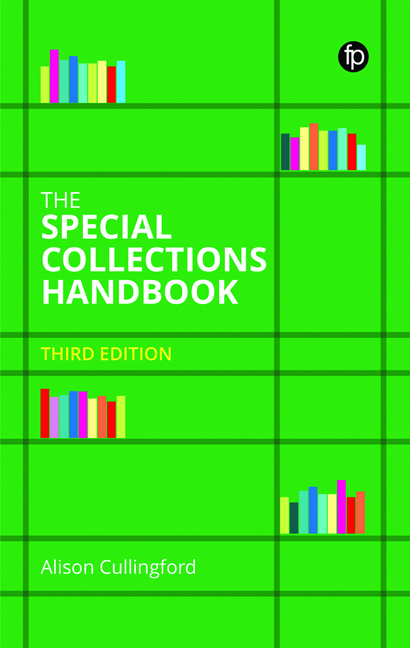Book contents
12 - Special Collections Spaces
Published online by Cambridge University Press: 28 April 2022
Summary
Introduction
Special Collections need appropriate spaces to house collections, to make them available and to work on them. We’ve already outlined the ideals for storage areas, exhibition spaces, reading rooms and group facilities. This chapter explores Special Collections spaces holistically. It covers:
1 Introduction to Special Collections spaces.
2 Functions and their space requirements.
3 Sizing spaces.
4 How to improve space with building projects.
5 How to cope with inadequate spaces.
6 Suggestions for further reading and useful websites.
Standards
Buildings and their management are governed by local and national legislation, planning regimes and standards. Note also the standards in Chapter 2 and Pacifico and Wilsted (2009), guidelines for archives facilities approved by the Society of American Archivists.
Important standards for sustainability:
• LEED (Leadership in Energy and Environmental Design), rating green buildings
• BREEAM, a sustainability assessment method for masterplanning projects, infrastructure and buildings.
Special Collections functions and their space requirements
Special Collections premises should be suited to the various functions that take place within them and have appropriate and logical connections and flows of people and collections between spaces.
Figure 12.1 on the next page, a simplified version of a diagram in Kitching (2007) for archives services, shows the key functions and flows in a Special Collections service.
Services may appear much more complex than this diagram, with outstores, exhibitions and other facilities outside their main building, or various branches and buildings. However, the functions represented are common to all Special Collections.
Functions and their space requirements
These functions do not necessarily have to take place in discrete spaces: a space may be used for multiple purposes.
Boundaries
Note the significance of the boundary between public spaces and staff-only spaces.
Other important boundaries:
• Between public spaces open to everyone, such as cafés, shops and exhibitions, and stricter control over reading rooms. Such a structure allows a service to welcome the public and generate income from retail, etc., but maintains security and preservation for objects.
• Areas of tighter security within the non-public areas, e.g., stores restricted to certain staff.
Flows
The key flows are those of collections and of people (i.e., users and the general public). For security reasons, these flows are kept separate except in designated areas: the reading room, exhibition area and learning spaces such as teaching or meeting rooms.
- Type
- Chapter
- Information
- The Special Collections Handbook , pp. 289 - 308Publisher: FacetPrint publication year: 2022



